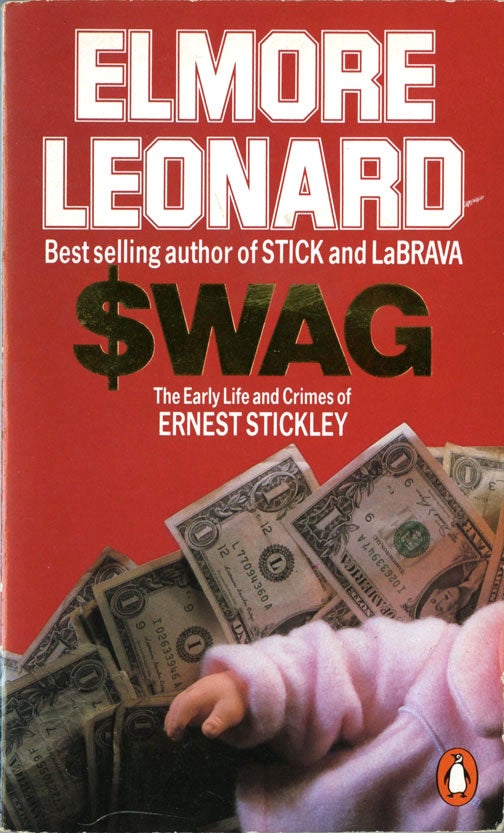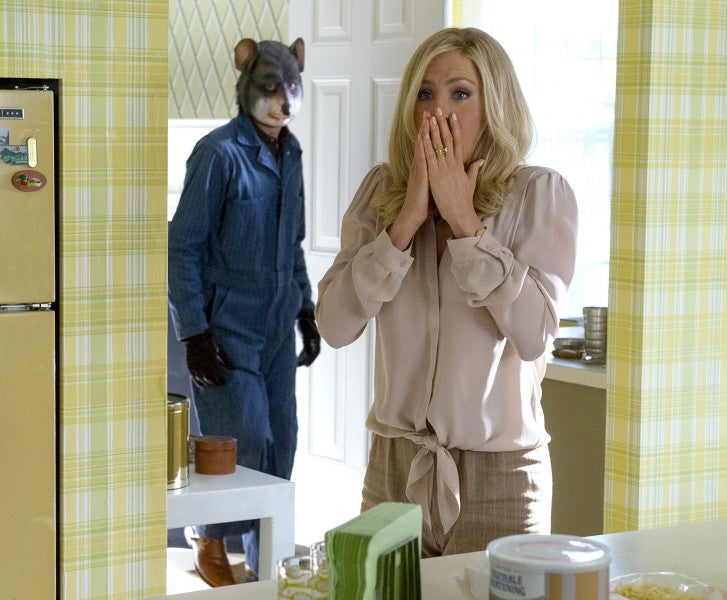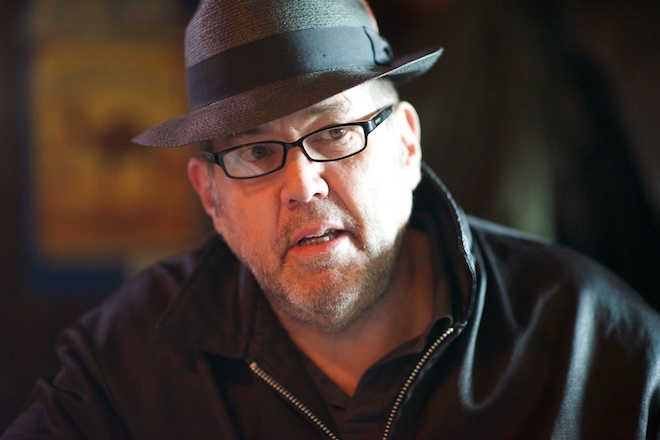Hard to imagine having a cooler job than the one Gregg Sutter had for more than 30 years, when he served as the late Elmore Leonard’s researcher. Sutter is the editor of the Library of America’s Elmore Leonard anthology, which will be released in three volumes, the first of which was published a few weeks ago (volume two comes next year, volume three in 2016). The first volume features Leonard’s early Detroit crime novels—Fifty-Two Pick Up, Swag, Unknown Man No. 89 (excerpted here), and The Switch. I recently had the chance to talk to Sutter about the great Dutch Leonard. Dig in.—A.B.
Alex Belth: Elmore Leonard might be our most famous crime writer yet he wasn’t influenced by Raymond Chandler or Dashiell Hammett.
Gregg Sutter: He wasn’t, that’s right. His influences were Hemingway, major; Steinbeck, minor; throw in a little James M. Cain, while you’re at it. Dutch used to pick up Hemingway short stories at random and start reading, to get the juices flowing. He loved Hemingway but thought he had no sense of humor. Which is why Richard Bissell’s novels, particularly High Water and A Stretch on the River, caught his attention. Bissell’s stories had a natural humor that Hemingway lacked.
Alex: I’m not familiar with Bissell at all.
Gregg: He’s not well known, but worth checking out. In contemporary fiction, Elmore was a big fan of Paris Trout, and Pete Dexter in general. He read a lot but only certain books consistently earned his praise. He’d carry a list of favorites when he gave speeches—so he didn’t forget anybody. On that list would be Dexter, George Higgins, Andre Dubus, Mark Harris, Jim Harrison, Raymond Carver, and Bobbie Ann Mason among others.
Alex: What about Fat City, by Leonard Gardner?
Gregg: I know he had it on his shelf. He liked the movie.
Alex: And The Professional, by W. C. Heinz.
Gregg: Of course. Elmore wrote the foreword to the 2001 reprint of that novel. They were friends.
Alex: I think it’s fascinating that The Friends of Eddie Coyle by George Higgins was a revelation for Elmore. That was in 1972.

Gregg: His agent told Dutch to read that novel before he wrote another word. Bear in mind, he had been writing for 22 years before he read Higgins. Eddie Coyle showed him how to loosen up and get into scenes quicker and a whole lot more.
Alex: What about when he started out?
Gregg: He always said that beginning writers should not be afraid to imitate. John D. MacDonald, an early supporter of his, told him you had to write a million words to find your sound.
Alex: That’s funny because so many writers or artists, especially when they are young, think they are going to reinvent the form. They hate the idea of being compared with anyone.
Gregg: He maintained that there is no shame in imitating at first. When he started out, he saw the genres and chose westerns because he loved western movies. Loved them since he was a kid. He used to “tell” movies to his friends. He was good at storytelling even at a young age. And so he thought, “I can write westerns.”
Alex: Did he want to be a writer in high school and college?
Gregg: Elmore wrote a little then, but it was the death of his father that set him on the writer’s path. In 1948, his father, Elmore John Leonard Sr, earned the ultimate reward for a GM man—his own dealership, in Las Cruces, New Mexico. Dutch was set to go to work for his dad at the dealership. He was preparing to go to dealer’s-son school upon graduation from college. But six months after getting his dealership, Elmore Sr. dropped dead of a cerebral hemorrhage. Dutch and his brother-in-law made a little stab to keep the dealership going. GM Holding wouldn’t let them take over payments for the dealership. Some GM executive asked Dutch what he wanted to do in life, and he said he was interested in writing and perhaps advertising. The GM man gave Dutch a connection at the Campbell Ewald ad agency. Elmore went to work there as the youngest, married office boy. He worked there for a few years, then left for a smaller agency, where he got necessary experience, then returned to Campbell Ewald on the Chevrolet account.
Alex: And he was writing all along, yes?
Gregg: From 1951–’61 he wrote about 30 western stories and 5 western novels, the last of which was Hombre. When he left advertising he took his profit-sharing bonus and decide to write a non-western novel. But his wife, Beverly, had her eyes on a house in Birmingham, a fashionable suburb of Detroit. So he bought the house and had to figure out another way to make a living. He had four kids at the time, so he wrote scripts for educational films for Encyclopedia Britannica, did freelance advertising, including work for George Hurst, of Hurst Floor Shifter fame. He wrote his ads that appeared in magazines like Hot Rod and Motor Trend. That was the early- to mid-’60s. Then, in ‘66, he got the check for the movie rights to Hombre, and that money was enough that he could get back into novel writing. He wrote his first non-western, The Big Bounce, which featured Jack Ryan, who later appeared in Unknown Man No. 89.
Alex: Was there any change in the character from the two books?
Gregg: Yeah, by Unknown Man No. 89, Jack had matured, and was a mostly legit process server in Detroit. Elmore liked the character. He loved Stick [Ernest Stickley, one of the two leads in Swag and later the star of his own novel]—until Burt Reynolds got a hold of him.

Alex: Was there anything that he picked up in the rhythm of the advertising world for his prose?
Gregg: He’d be asked what he learned from his advertising career and he’d say, “Nothing.” Or, virtually nothing. OK, he got some good stories out of that world but Elmore wasn’t geared for the kind of cute, alliterative ad talk. Like the 1961 Chevrolet: “Sixty-Wonderful.” He wasn’t into cute. There’s a great story about him getting sent out to talk to Chevy truck owners in 1958 or so. He’s out West talking and drinking with Chevy truck owners and he asks one of them to tell him something colloquial about their trucks that he could use in a testimonial ad. One guy says, “You don’t wear the son of a bitch out, you just get tired looking at it and buy a new one.” But the agency and client would never go for that kind of truthfulness.
Alex: I love this passage from Unknown Man No. 89: “He had read books on customer and employee relations, how to win friends, close deals, improve your personality and make a million dollars. He hadn’t finished most of them. He was not a salesman or a joiner or a joke-teller. He was himself. He relied on common sense but was not afraid to gamble. He gave his word and delivered.” That sounds as if he’s describing himself.
Gregg: That’s the essence of Elmore. Just be yourself. Authenticity was very important to him. A guy who’s going to rob a bank on a particular day has to decide what tie to wear, just like the guy going to the office. He liked his bad guys, except Teddy Magyk [from Leonard’s first best-seller, 1985’s Glitz], perhaps the only character he did not like. Teddy was a bit too creepy. Elmore hated the sneering bad-guy stereotype because nobody is all bad. That’s one of the reasons the bad guys’ points of view have equal weight in his novels.
Alex: Which is one of the reasons why his books are so cinematic.
Gregg: Movies and books are inextricably connected in Elmore’s career, especially in the years 1967 to 1974. He would write a novel like The Moonshine War and then write the screenplay. Or he’d write a screenplay, then a novel. For example, Mr. Majestyk started as a script for Clint Eastwood, got made into a movie with Charles Bronson instead, and then Elmore wrote a novelization of his script. Going back and forth between screenplays and novels in the six years before Fifty-Two Pick Up created a structure where his novels resembled a screenplay, particularly because he moved his stories with dialogue, not exposition. This tendency made his work attractive to producers, who thought his work would be easy to adapt. For some, it was. For others, who focused on the story more than the characters and dialogue, it was a disaster.
Alex: Fifty-Two Pick Up was the start of an incredible run.
Gregg: I always thought of the first three books in this volume—Fifty-Two Pick Up, Swag, and Unknown Man No. 89—as a trilogy. They come out of the same post-Higgins big bang.
Alex: What about The Switch? [The book was recently made into the movie Life of Crime.]
Gregg: The Switch was published as a Bantam paperback, not part of the previous hardcover deal with Delacorte. He had written The Hunted, for Dell, in between. The Switch was his first novel that featured a female lead. It also had an autobiographical element, in his wicked descriptions of suburban country-club life. He and his friends had social memberships to the club and would go there on weekends to drink and party.
Alex: Did that coincide with him not drinking?
Gregg: He did quit around the time he wrote The Switch. He always said that drinking did not interfere with his writing and he didn’t drink while he was writing. Elmore never lost interest in alcohol as a literary device even after he got sober. The descriptions of the drinks—bourbon, with a little bit of sugar, the Salty Dogs, in Swag—made the reader thirsty. They were written with great care. He still loved the idea of drinking even though he was on the wagon.

Alex: In Fifty-Two Pick Up, Leonard writes, “He was beginning to get the good feeling of confidence again, the feeling of being keyed up but able to remain calm.” And in The Switch, he writes, “She was excited but calm … she could be herself.” This comes up time and again for his characters, excited but calm.
Gregg: He’s like his characters—cool under pressure.
Alex: I’ve talked to Pete Dexter about how he writes and he’s like Leonard—he makes it up as he goes along. This isn’t to say he doesn’t do a lot of revising, he does, but he doesn’t know where the thing is going when he starts.
Gregg: In the time that I am most familiar with, Elmore’s motto was the same: I make it up as I go along. He would wake up in the morning and approach the next scene fresh, not looking too far ahead in the story.
Alex: Surviving by his wits, just like his characters.
Gregg: In a manner of speaking. He didn’t outline. I think many authors are terrified not knowing what happens next. But the unknown pleased him. And you write to please yourself, he always said.
Alex: How did he work?
Gregg: He’d write longhand on unlined yellow pads and when he was satisfied enough, he’d type up pages on his IBM Wheelwriter. His daughter Jane typed the final manuscript that was sent to the publisher. But it was always handwritten first. The pages he wrote today, he would rewrite tomorrow. When he reached the end, he was done.
Alex: So he didn’t revise the entire thing once he finished a draft?
Gregg: No, he wrote a few pages, revised them, locked the scene, and pressed on. By the time he got to the end of the first act, around manuscript page 120 or so, all the characters would be in place. Around page 300, he’d go, “Time to end it.” And he’d start winding down the story. Sometimes, you’d see a page and it’d be a scene and sometimes it wasn’t even in the book. It was just an exercise to get these people in a situation and get them to start talking. Because if you didn’t talk in his books, he always said, you might get shot. Conversely, if you were a minor character and you could talk, like the Miskito Indian, Franklin, in Bandits, then you get a bigger part.
Alex: There is such a rhythm to his prose—did he ever write aloud? Or did he lock himself in his office with a “Do Not Disturb” sign, like some writers?
Gregg: No, Elmore actually picked up the phone while he was writing. During the call, he’d read you the scene he was working on. You’d think, “Wow, I’m special, he’s reading to me.” The fact of the matter is, he’d read to almost anybody. He used the interruption to his advantage, like the runner at a red light, running in place. He’d read a scene aloud to kept the rhythm going.
Alex: You were his researcher for more than 30 years. Your association with him started where volume two of the Library of America series picks up and we’ll talk more about your working relationship with Elmore when that is published next fall. But even before you worked together his books have a wonderful sense of detail. Was he a curious guy by nature?
Gregg: Oh, yeah. Elmore was a great listener. When you spoke to him, he was always waiting and hoping you’d say something interesting that he could use. My favorite example was the time he got roped into going to the opera with his wife. He was not keen about the opera but he met a guy there in the lobby and started to chit-chat with him and asked, “What do you do?” and the guy tells him, “I’m a bull-semen salesman.” Bingo, you just knew there would be a bull-semen salesman in his next book (Mr. Paradise), and there was:
Delsa had to ask, “How does he get the semen?”
“As I understand it,” Tony said, “they use an artificial cow’s vagina and get the bull to ejaculate into it. Or they give him a hand job or stick an electric rod up his ass. There’re different ways. You’d have to talk to John about it.”
Elmore Leonard: Four Novels of the 1970s is available now. For more on Leonard, check out his website, as well as Sutter’s site.
[Photo credit: via Gregg Sutter]
